Massive MIMO-Based Distributed Signal Detection in Multi-Antenna Wireless Sensor Networks †
Abstract
1. Introduction
1.1. Background and Motivation
1.2. Related Work
1.3. Contributions
- We formulate a system model on multi-antenna sensors distributed detection network, which characterizes the influence of multi-antenna sensors on the performance of the distributed detection network.
- We derive an optimal detector with multi-antenna sensor distributed detection network, and a closed-form expression of detection probability. Based on that, we perform the detection probability upper bound performance analysis on the multi-antenna sensor network which lays a theoretical foundation for the subsequent optimization.
- We transform the power-constrained optimization problem into a non-convex fractional programming problem with multiple optimization variables. Subject to the sum of reporting sensor power, the average power allocation algorithm is compared to verify the superiority of our optimization scheme. In addition, we analyzed the trade-off between the number of fusion center antennas and the reported power.
1.4. Notation
2. System Model
3. Multi-Antenna Sensor Distributed Network Detector
4. Performance Analysis and Optimization
4.1. Detection Performance Analysis
4.2. Lagrangian Function Preprocessing
4.3. Power Optimization Algorithm
- -
- Step one: Update , and fixed .Obviously, this belongs to a multivariate quadratic programming problem, which is cumbersome to solve, but we find that the variable t is not coupled with other variables. Therefore, we can find the vertices of the parabola by decomposing and optimizing the variables in Equation (29), and we get the closed-form expression solution as
- -
- Step two: Update , and fixed .To simplify understanding, we introduce the following notation: and . We can get the equivalent transformation of Equation (31) as follows,Furthermore, introduce the notations , , , , , , , the optimization problem in Equation (32) can be equivalently expressed using the above symbols:
- -
- Step three: Update , and fixed , , .
- -
- Step four: Update .where the value of determines whether the penalty function is constant or variable, the initial selection of penalty parameters in [45] suggests the use of parameters (i.e., > 1) to improve convergence performance and reduce losses.
| Algorithm 1 ADMM for Sensor Reporting Power Optimization |
5. Simulation Results
6. Conclusions
Author Contributions
Funding
Acknowledgments
Conflicts of Interest
Abbreviations
| MIMO | Multiple-input multiple-output |
| ADMM | Alternating direction method of multipliers |
| WSNs | Wireless sensor networks |
| FC | fusion center |
| 5G | fifth-generation |
| CRNs | cognitive radio networks |
| CSI | channels state information |
| NP | Neyman–Pearson |
| EPA | Equal power allocation |
| QP | Quadratic programming |
| probability density function |
Appendix A. Proof of Equation (11)
Appendix B. Proof of Equation (20)
Appendix C. Proof of Equation (22)
References
- Chamberland, J.F.; Veeravalli, V.V. Asymptotic results for decentralized detection in power constrained wireless sensor networks. IEEE J. Sel. Areas Commun. 2004, 22, 1007–1015. [Google Scholar] [CrossRef]
- Cui, S.; Xiao, J.; Goldsmith, A.; Luo, Z.Q.; Poor, H.V. Estimation diversity and energy efficiency in distributed sensing. IEEE Trans. Signal Process. 2007, 55, 4683–4695. [Google Scholar]
- Quan, Z.; Ma, W.; Cui, S.; Sayed, A.H. Optimal linear fusion for distributed detection via semidefinite programming. IEEE Trans. Signal Process. 2010, 58, 2431–2436. [Google Scholar] [CrossRef]
- Ding, G.; Wu, Q.; Yao, Y.; Wang, J.; Chen, Y. Kernel-based learning for statistical signal processing in cognitive radio networks: Theoretical foundations, example applications, and future directions. IEEE Signal Process Mag. 2013, 30, 126–136. [Google Scholar] [CrossRef]
- Zhang, X.; Poor, H.V.; Chiang, M. Optimal power allocation for distributed detection over MIMO channels in wireless sensor networks. IEEE Trans. Signal Process. 2008, 56, 4124–4140. [Google Scholar] [CrossRef]
- Rusek, F.; Persson, D.; Lau, B.K.; Larsson, E.G.; Marzetta, T.L.; Edfors, O.; Tufvesson, F. Scaling Up MIMO: Opportunities and challenges with very large arrays. IEEE Signal Process Mag. 2013, 30, 40–60. [Google Scholar] [CrossRef]
- Larsson, E.G.; Tufvesson, F.; Edfors, O.; Marzetta, T.L. Massive MIMO for next generation wireless systems. IEEE Commun. Mag. 2014, 52, 186–195. [Google Scholar] [CrossRef]
- De Figueiredo, F.A.P.; Dias, C.F.; de Lima, E.R.; Fraidenraich, G. Capacity bounds for dense massive MIMO in a line-of-sight propagation environment. Sensors 2020, 20, 520. [Google Scholar] [CrossRef]
- Choi, K.J.; Lee, S.R.; Kim, K.S.; Kim, K.J. Multi-user massive MIMO for next-generation WLAN systems. Electron. Lett. 2015, 51, 792–794. [Google Scholar]
- Gesbert, D.; Kountouris, M.; Heath, R.W.; Chae, C.B.; Salzer, T. Shifting the MIMO paradigm. IEEE Signal Process Mag. 2007, 24, 36–46. [Google Scholar] [CrossRef]
- Ngo, H.Q.; Larsson, E.G.; Marzetta, T.L. Energy and spectral efficiency of very large multiuser MIMO Systems. IEEE Trans. Commun. 2013, 61, 1436–1449. [Google Scholar]
- Zhang, X.; Guo, D.; An, K.; Ding, Z.; Zhang, B. Secrecy analysis and active pilot spoofing attack detection for multigroup multicasting cell-free massive MIMO systems. IEEE Access 2019, 7, 57332–57340. [Google Scholar] [CrossRef]
- Banavar, M.K.; Smith, A.D.; Tepedelenliolu, C.; Spanias, A. Distributed detection over fading MACs with multiple antennas at the fusion center. In Proceedings of the 2010 IEEE International Conference on Acoustics, Speech and Signal Processing, Dallas, TX, USA, 14–19 March 2010. [Google Scholar] [CrossRef]
- Banavar, M.K.; Smith, A.D.; Tepedelenlioglu, C.; Spanias, A. On the effectiveness of multiple antennas in distributed detection over fading MACs. IEEE Trans. Wirel. Commun. 2012, 11, 1744–1752. [Google Scholar] [CrossRef]
- Bjrnson, E.; Hoydis, J.; Kountouris, M.; Debbah, M. Massive MIMO systems with non-ideal hardware: Energy efficiency, estimation, and capacity limits. IEEE Trans. Inf. Theory 2013, 60, 7112–7139. [Google Scholar] [CrossRef]
- Tenney, R.R.; Sandell, N.R. Detection with distributed sensors. IEEE Trans. Aerosp. Electron. Syst. 1981, 17, 501–510. [Google Scholar] [CrossRef]
- Ciuonzo, D.; Rossi, P.S.; Dey, S. Massive MIMO channel-aware decision fusion. IEEE Trans. Signal Process. 2015, 63, 604–619. [Google Scholar] [CrossRef]
- Feng, J.; Jie, C.; Swindlehurst, A.L.; Lopezsalcedo, J.A. Massive MIMO for wireless sensing with a coherent multiple access channel. IEEE Trans. Signal Process. 2014, 63, 3005–3017. [Google Scholar]
- Seshukumar, K.; Saravanan, R.; Suraj, M.S. Spectrum sensing review in cognitive radio. In Proceedings of the 2013 International Conference on Emerging Trends in VLSI, Embedded System, Nano Electronics and Telecommunication System (ICEVENT), Tiruvannamalai, India, 7–9 January 2013. [Google Scholar] [CrossRef]
- Zhang, P.; Nevat, I.; Peters, G.W.; Xiao, G.; Tan, H. Event detection in wireless sensor networks in random spatial sensors deployments. IEEE Trans. Signal Process. 2015, 63, 6122–6135. [Google Scholar] [CrossRef]
- Lee, C.C. Security and privacy in wireless sensor networks: Advances and challenges. Sensors 2020, 20, 744. [Google Scholar] [CrossRef]
- Blum, R.S.; Kassam, S.A.; Poor, H.V. Distributed detection with multiple sensors II. Advanced topics. Proc. IEEE 1997, 85, 64–79. [Google Scholar] [CrossRef]
- Li, W.; Dai, H. Distributed detection in wireless sensor networks using a multiple access channel. IEEE Trans. Signal Process. 2007, 55, 822–833. [Google Scholar] [CrossRef]
- Qi, C.; Chen, B.; Varshney, P.K. Detection performance limits for distributed sensor networks in the presence of nonideal channels. IEEE Trans. Wirel. Commun. 2006, 5, 3034–3038. [Google Scholar]
- Chen, B.; Jiang, R.; Kasetkasem, T.; Varshney, P.K. Fusion of decisions transmitted over fading channels in wireless sensor networks. IEEE Trans. Signal Process. 2006, 54, 1018–1027. [Google Scholar]
- Chen, B.; Willett, P.K. On the optimality of the likelihood-ratio test for local sensor decision rules in the presence of nonideal channels. IEEE Trans. Inf. Theory 2005, 51, 693–699. [Google Scholar] [CrossRef]
- Smith, A.D.; Banavar, M.K.; Tepedelenlioglu, C.; Spanias, A. Distributed estimation over fading macs with multiple antennas at the fusion center. In Proceedings of the 2009 Conference Record of the Forty-Third Asilomar Conference on Signals, Systems and Computers, Pacific Grove, CA, USA, 1–4 November 2009. [Google Scholar] [CrossRef]
- Yuan, Y.; Zhu, L. Application scenarios and enabling technologies of 5G. China Commun. 2014, 11, 69–79. [Google Scholar] [CrossRef]
- Huo, Y.; Dong, X.; Xu, W.; Yuen, M. Enabling Multi-Functional 5G and Beyond User Equipment: A Survey and Tutorial. IEEE Access 2019, 7, 116975–117008. [Google Scholar] [CrossRef]
- Chawla, A.; Patel, A.; Jagannatham, A.K.; Varshney, P.K. Robust distributed detection in Massive MIMO wireless sensor networks under CSI uncertainty. In Proceedings of the 2018 IEEE 88th Vehicular Technology Conference (VTC-Fall), Chicago, IL, USA, 27–30 August 2018. [Google Scholar] [CrossRef]
- Ding, G.; Gao, X.; Xue, Z.; Wu, Y.; Shi, Q. Massive MIMO for distributed detection with transceiver impairments. IEEE Trans. Veh. Technol. 2018, 67, 604–617. [Google Scholar] [CrossRef]
- Zhang, Y.; Huo, Y.; Zhan, J.; Wang, D.; Dong, X.; You, X. ADMM Enabled Hybrid Precoding in Wideband Distributed Phased Arrays Based MIMO Systems. In Proceedings of the 2019 IEEE 90th Vehicular Technology Conference (VTC2019-Fall), Honolulu, HI, USA, 22–25 September 2019; pp. 1–5. [Google Scholar] [CrossRef]
- Wang, J.; Wang, Y. On the Design of Constant Modulus Probing Waveforms With Good Correlation Properties for MIMO Radar via Consensus-ADMM Approach. IEEE Trans. Signal Process. 2019, 67, 4317–4332. [Google Scholar] [CrossRef]
- Cheng, X.; Li, L.; Du, L. ADMM-based channel estimation for mmWave massive MIMO systems. In Proceedings of the 2017 3rd IEEE International Conference on Computer and Communications (ICCC), Chengdu, China, 13–16 December 2017; pp. 152–157. [Google Scholar] [CrossRef]
- Wei, G.; Zhao, B.; Guo, D.; Zhang, B.; Ma, X. Massive MIMO based distributed detection in multi-antenna sensor networks. In Proceedings of the 2019 IEEE 7th International Conference on Computer Science and Network Technology (ICCSNT), Dalian, China, 19–20 October 2019; pp. 422–426. [Google Scholar] [CrossRef]
- Jiang, F.; Chen, J.; Swindlehurst, A.L. Detection in analog sensor networks with a large scale antenna fusion center. In Proceedings of the 2014 IEEE 8th Sensor Array and Multichannel Signal Processing Workshop (SAM), A Coruna, Spain, 22–25 June 2014. [Google Scholar] [CrossRef]
- Kay, S.M. Detection Theory. In Fundamentals of Statistical Signal Processing; Prentice Hall: Upper Saddle River, NJ, USA, 1993. [Google Scholar]
- Yin, H.; Gesbert, D.; Filippou, M.; Liu, Y. A coordinated approach to channel estimation in large-scale multiple-antenna systems. IEEE J. Sel. Areas Commun. 2013, 31, 264–273. [Google Scholar] [CrossRef]
- Lu, L.; Li, G.Y.; Swindlehurst, A.L.; Ashikhmin, A.; Zhang, R. An Overview of Massive MIMO: Benefits and Challenges. IEEE J. Sel. Top. Sign. Process. 2014, 8, 742–758. [Google Scholar] [CrossRef]
- Shi, Q.; Cheng, P.; Xu, W.; Hong, M.; Cai, Y. Energy efficiency optimization for MISO SWIPT systems with zero-forcing beamforming. IEEE Trans. Signal Process. 2016, 64, 842–854. [Google Scholar] [CrossRef]
- Wang, C.F.; Juan, L.I.; Shen, P.P. A global optimization algorithm for sum of linear ratios problem. Math. Appl. 2013, 2013, 785–790. [Google Scholar]
- Boyd, S.; Parik, N.; Chu, E.; Peleato, B.; Eckstein, J. Distributed optimization and statistical learning via the alternating direction method of multipliers. Found. Trends Mach. Learn. 2010, 3, 1–122. [Google Scholar] [CrossRef]
- Grant, M.; Boyd, S.; Ye, Y. CVX Research, Inc. CVX: Matlab Software for Disciplined Convex Programming, Version 2.0. Available online: http://cvxr.com/cvx (accessed on 4 April 2020).
- MATLAB MathWorks, Optimization ToolboxTM. Available online: https://cn.mathworks.com/products/optimization/?requestedDomain=www.mathworks.com (accessed on 10 August 2019).
- Wang, S.; Liao, L. Decomposition method with a variable parameter for a class of monotone variational inequality problems. J. Optim. Theory Appl. 2001, 109, 415–429. [Google Scholar] [CrossRef]
- Vavasis, S.A. Complexity theory: Quadratic programming. In Encyclopedia of Optimization; Springer: Berlin/Heidelberg, Germany, 2009; Volume 2, pp. 451–454. [Google Scholar]
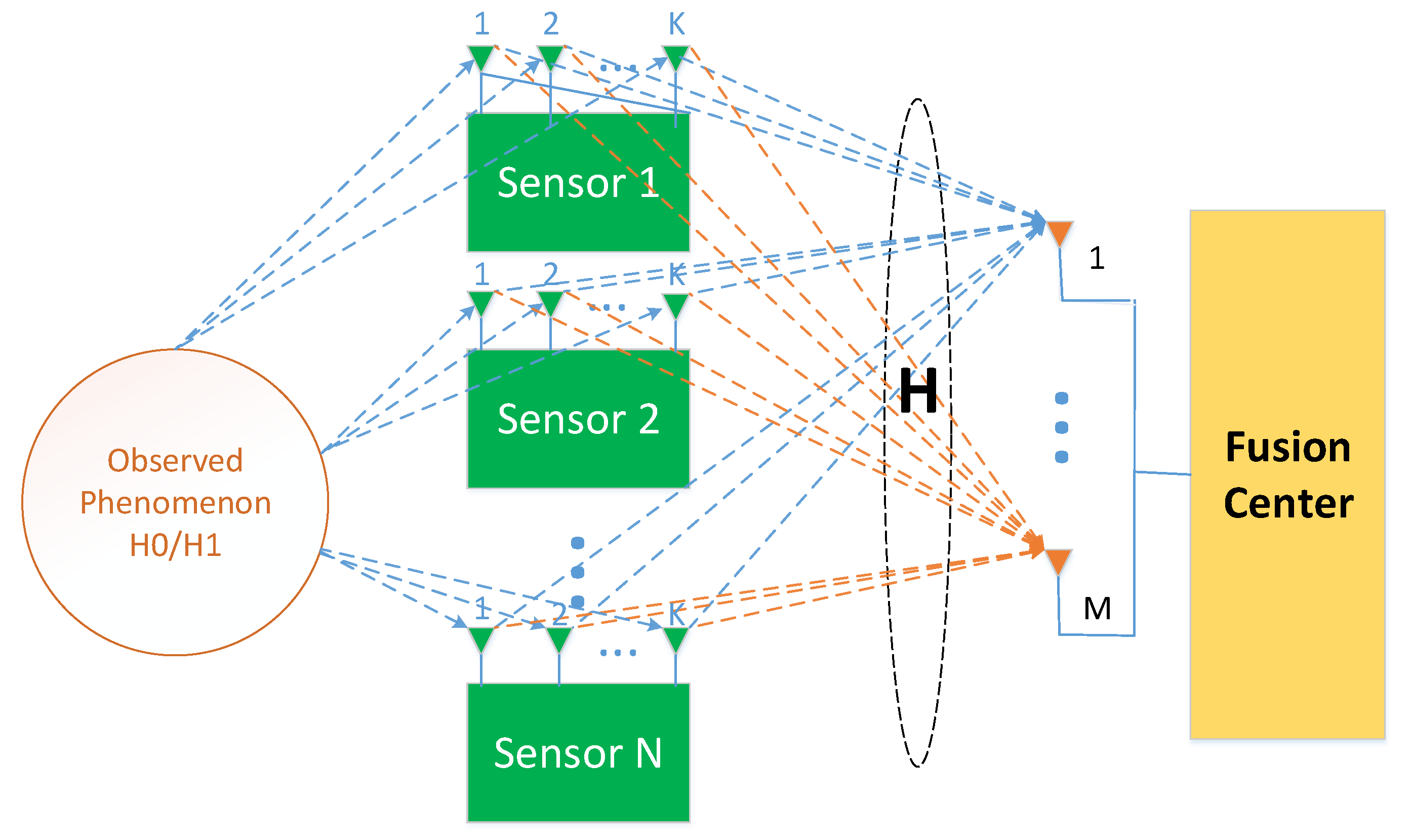
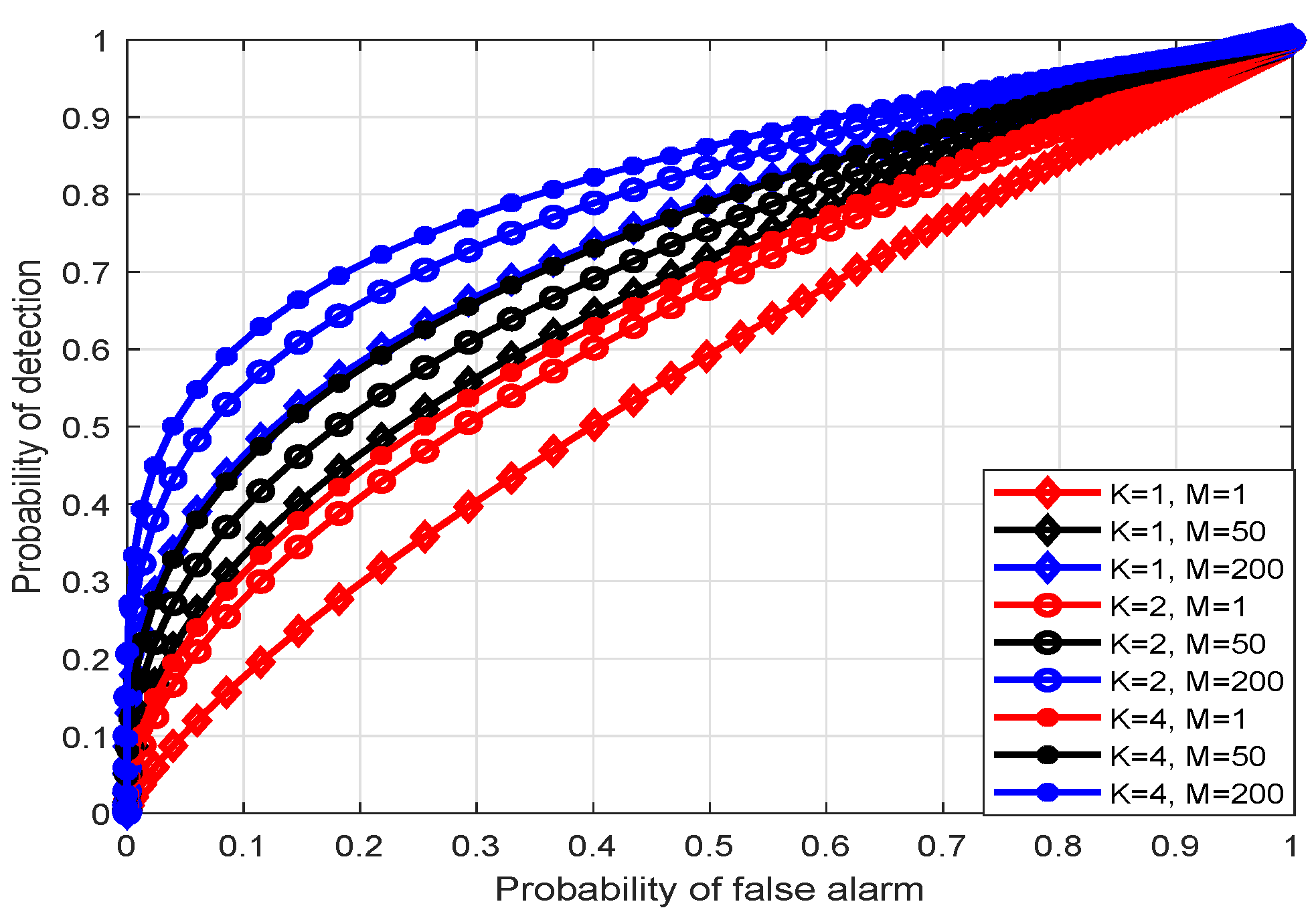
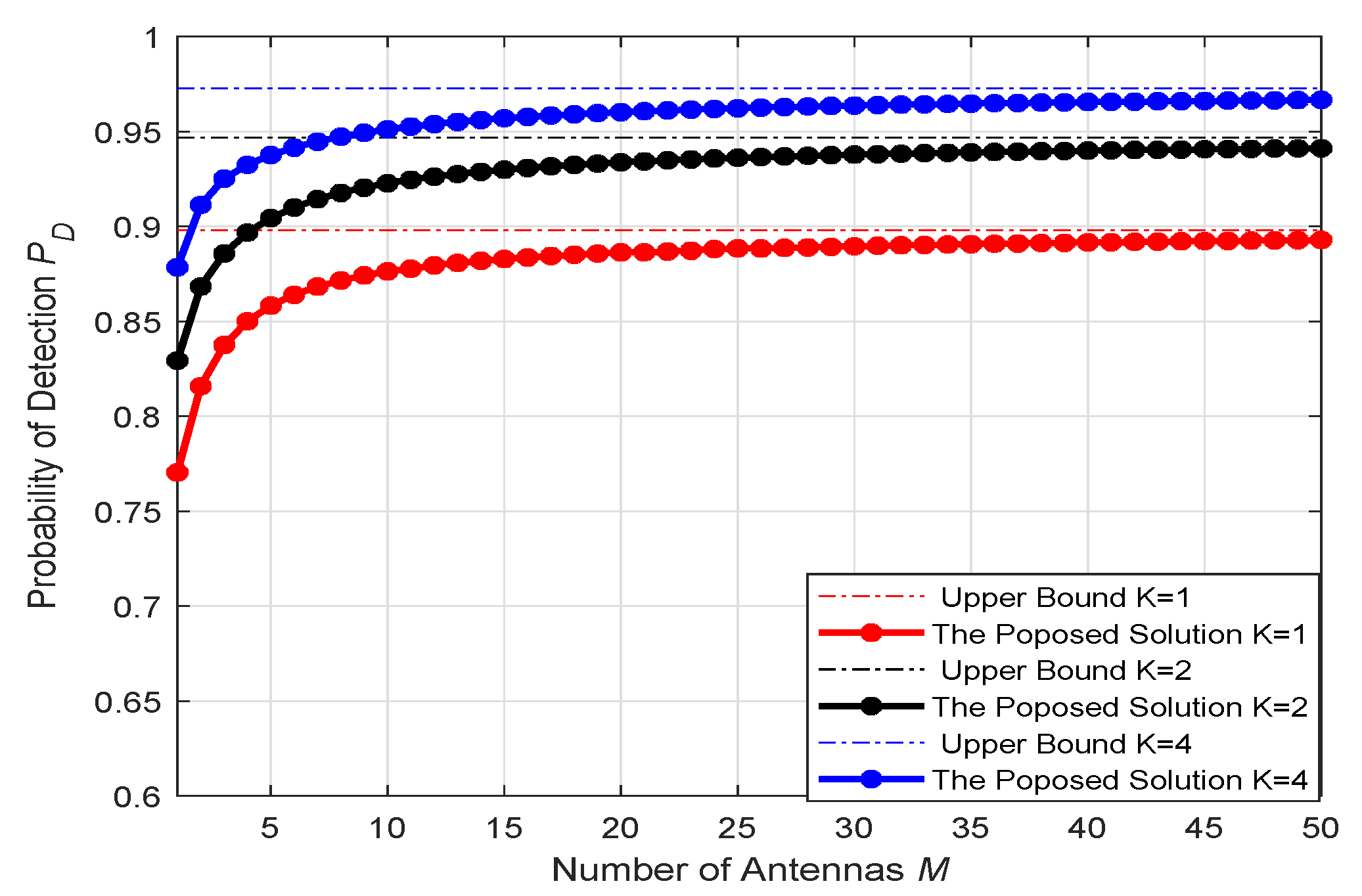
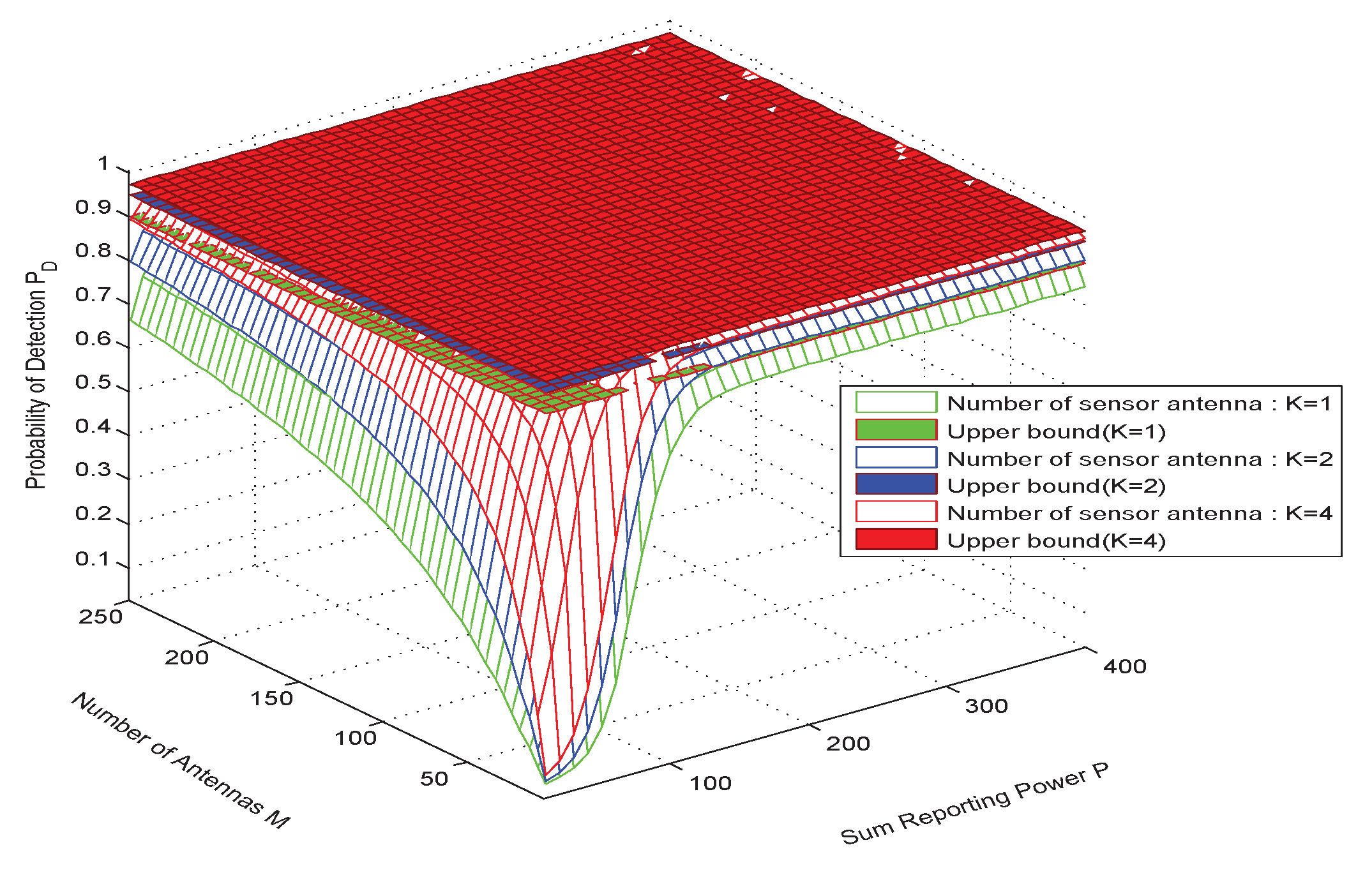
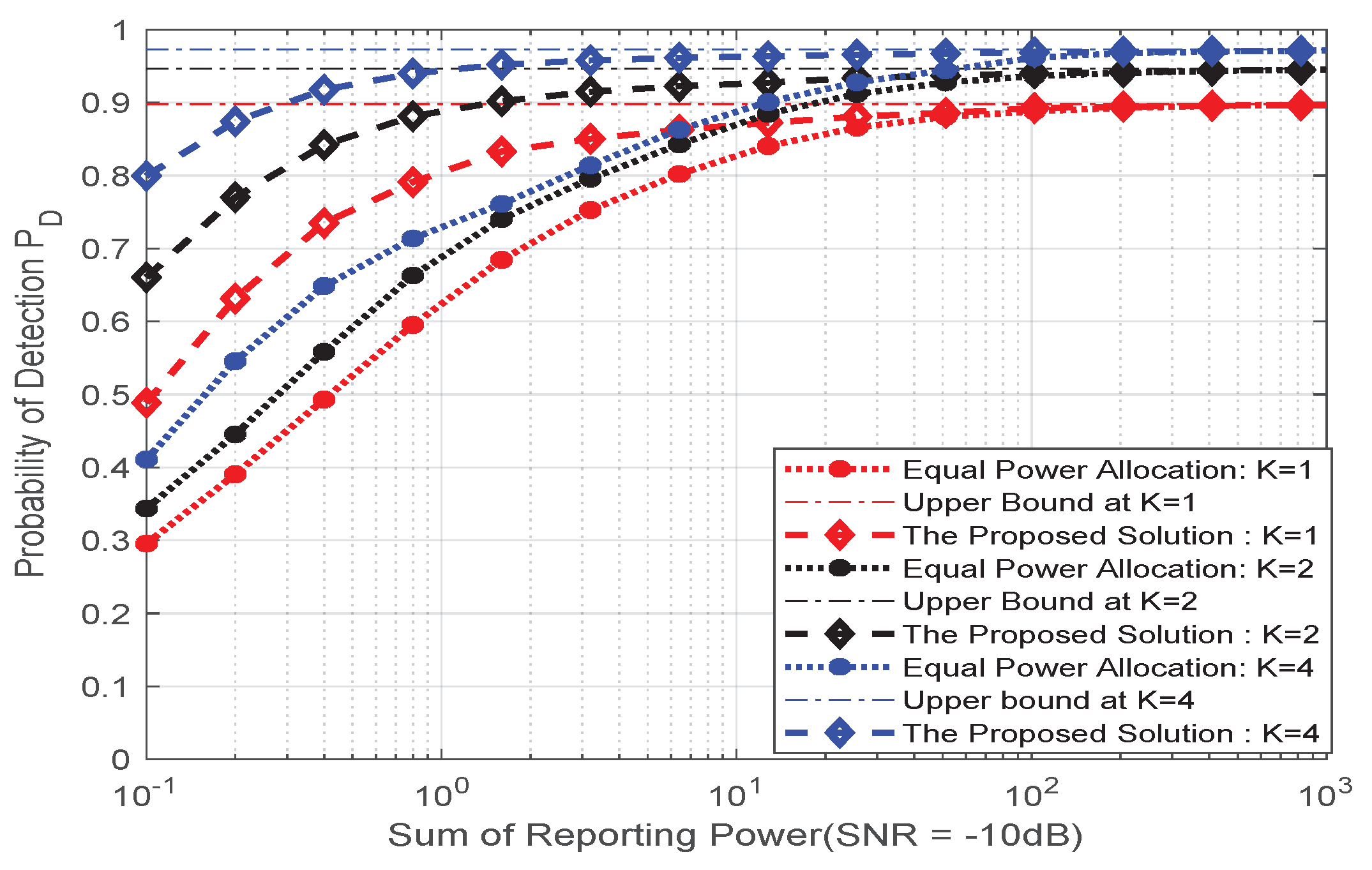
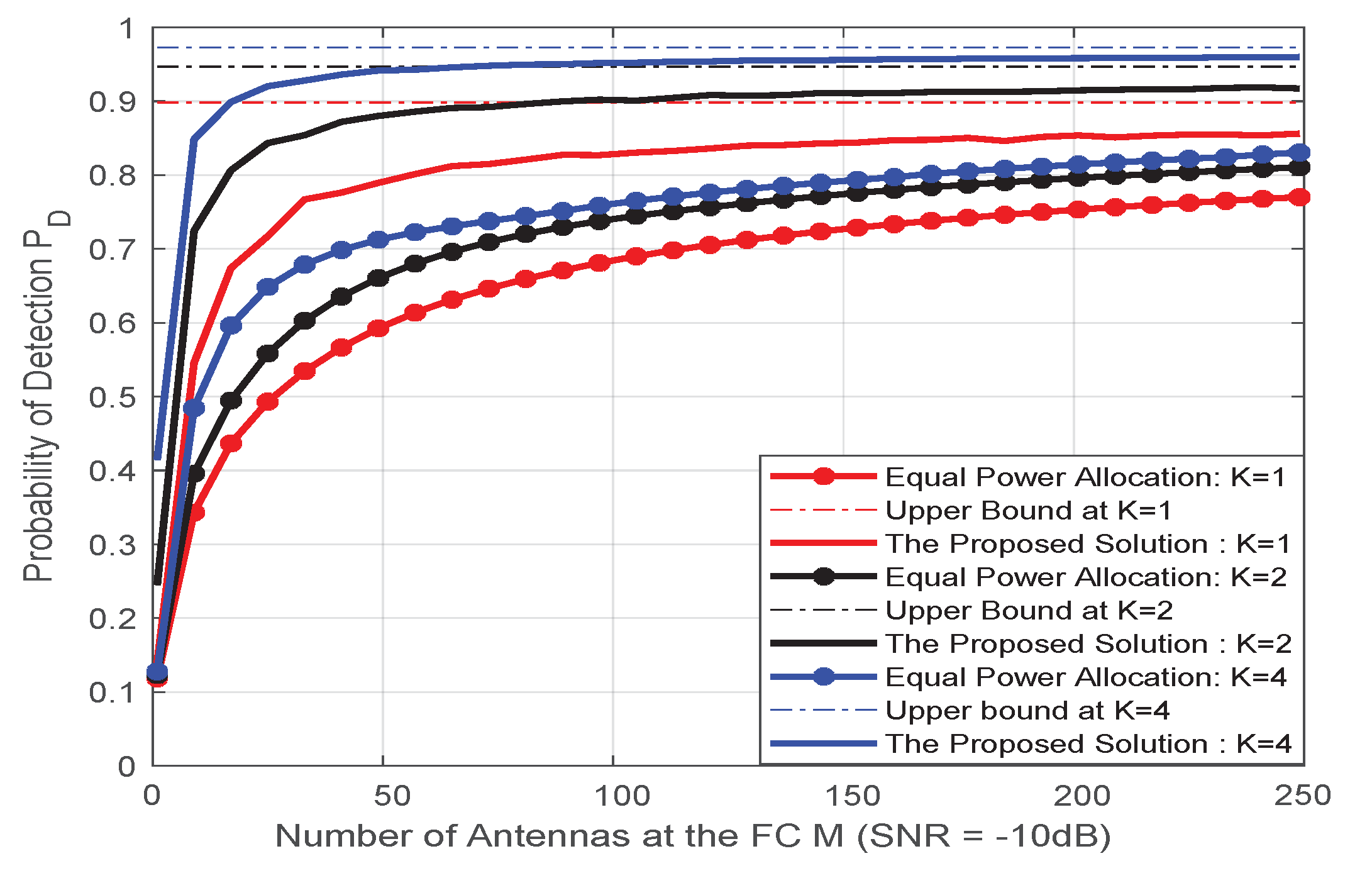
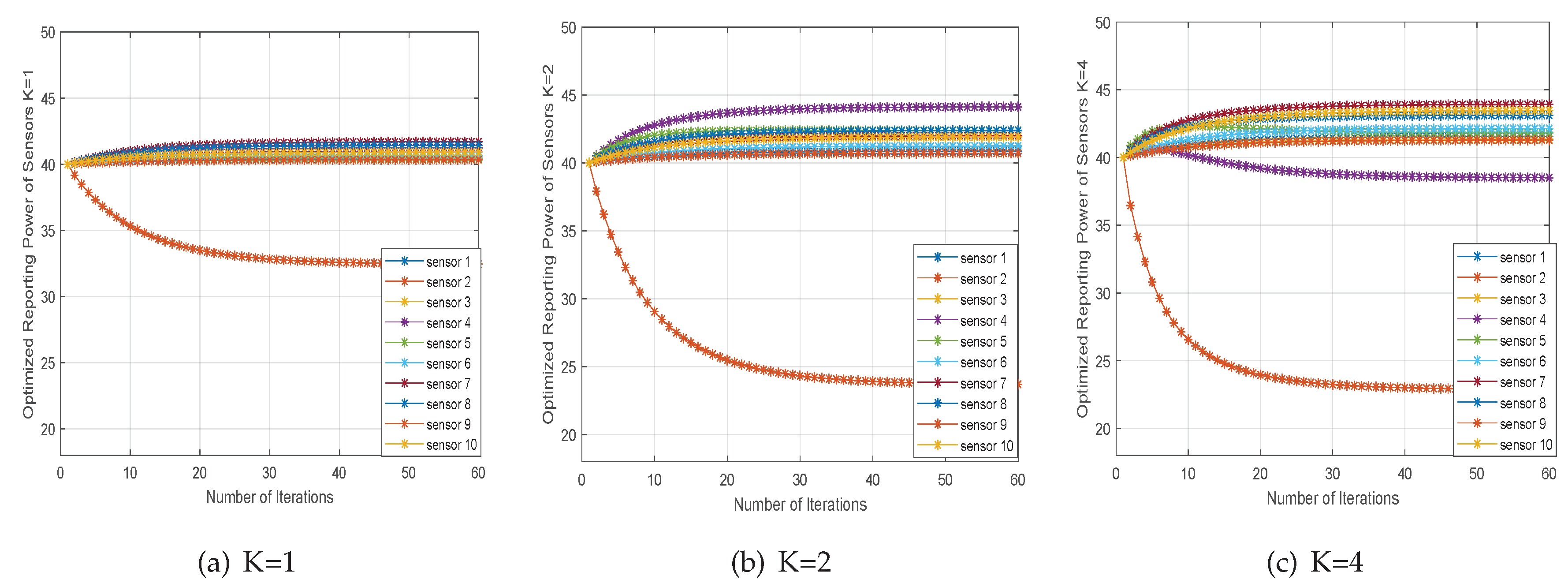
| Sensor | Distance | Algorithm | K = 1 | K = 2 | K = 4 | ||||
|---|---|---|---|---|---|---|---|---|---|
| Antenna 1 | Antenna 1 | Antenna 2 | Antenna 1 | Antenna 2 | Antenna 3 | Antenna 4 | |||
| Sensor 1 | 17.5024 | EPA | 40 | 20 | 20 | 10 | 10 | 10 | 10 |
| ADMM | 40.4157 | 20.4033 | 20.4033 | 10.3786 | 10.3785 | 10.3786 | 10.3785 | ||
| Sensor 2 | 3.3541 | EPA | 40 | 20 | 20 | 10 | 10 | 10 | 10 |
| ADMM | 32.4391 | 13.6643 | 13.6643 | 5.5409 | 5.5409 | 5.5409 | 5.5409 | ||
| Sensor 3 | 19.4117 | EPA | 40 | 20 | 20 | 10 | 10 | 10 | 10 |
| ADMM | 40.3439 | 20.3348 | 20.3348 | 10.3163 | 10.3163 | 10.3163 | 10.3163 | ||
| Sensor 4 | 6.4284 | EPA | 40 | 20 | 20 | 10 | 10 | 10 | 10 |
| ADMM | 41.2436 | 20.8386 | 20.8386 | 10.1989 | 10.1989 | 10.1989 | 10.1989 | ||
| Sensor 5 | 5.9324 | EPA | 40 | 20 | 20 | 10 | 10 | 10 | 10 |
| ADMM | 40.4732 | 19.9291 | 19.9291 | 9.2390 | 9.2390 | 9.2390 | 9.2390 | ||
| Sensor 6 | 14.0173 | EPA | 40 | 20 | 20 | 10 | 10 | 10 | 10 |
| ADMM | 40.6488 | 20.6298 | 20.6301 | 10.5923 | 10.5923 | 10.5923 | 10.5923 | ||
| Sensor 7 | 8.3763 | EPA | 40 | 20 | 20 | 10 | 10 | 10 | 10 |
| ADMM | 41.7096 | 21.6313 | 21.6313 | 11.4725 | 11.4725 | 11.4724 | 11.4725 | ||
| Sensor 8 | 8.6594 | EPA | 40 | 20 | 20 | 10 | 10 | 10 | 10 |
| ADMM | 41.4424 | 21.3406 | 21.3406 | 11.1425 | 11.1426 | 11.1425 | 11.1425 | ||
| Sensor 9 | 19.7629 | EPA | 40 | 20 | 20 | 10 | 10 | 10 | 10 |
| ADMM | 40.3553 | 20.3509 | 20.3509 | 10.3413 | 10.3413 | 10.34136 | 10.3413 | ||
| Sensor 10 | 11.0626 | EPA | 40 | 20 | 20 | 10 | 10 | 10 | 10 |
| ADMM | 40.9284 | 20.8770 | 20.8771 | 10.7777 | 10.7776 | 10.7778 | 10.7776 |
© 2020 by the authors. Licensee MDPI, Basel, Switzerland. This article is an open access article distributed under the terms and conditions of the Creative Commons Attribution (CC BY) license (http://creativecommons.org/licenses/by/4.0/).
Share and Cite
Wei, G.; Zhang, B.; Ding, G.; Zhao, B.; Wei, Y.; Guo, D. Massive MIMO-Based Distributed Signal Detection in Multi-Antenna Wireless Sensor Networks. Sensors 2020, 20, 2005. https://doi.org/10.3390/s20072005
Wei G, Zhang B, Ding G, Zhao B, Wei Y, Guo D. Massive MIMO-Based Distributed Signal Detection in Multi-Antenna Wireless Sensor Networks. Sensors. 2020; 20(7):2005. https://doi.org/10.3390/s20072005
Chicago/Turabian StyleWei, Guofeng, Bangning Zhang, Guoru Ding, Bing Zhao, Yimin Wei, and Daoxing Guo. 2020. "Massive MIMO-Based Distributed Signal Detection in Multi-Antenna Wireless Sensor Networks" Sensors 20, no. 7: 2005. https://doi.org/10.3390/s20072005
APA StyleWei, G., Zhang, B., Ding, G., Zhao, B., Wei, Y., & Guo, D. (2020). Massive MIMO-Based Distributed Signal Detection in Multi-Antenna Wireless Sensor Networks. Sensors, 20(7), 2005. https://doi.org/10.3390/s20072005





